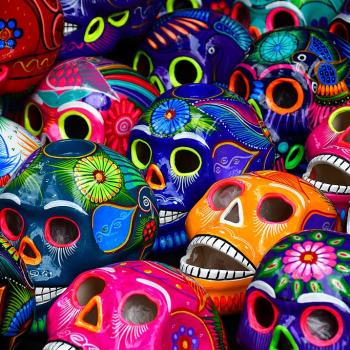Spoilerous.
# I read my sister’s copy of IT over one day and one night of summer break, sprawled on (I think) her bed in a sweltering DC attic, reading until my eyes burned and I was barely taking in words but unable to put it down and go to sleep. I started it sometime in early afternoon, I think, and finally finished in full sunlight the next day. There’s something in IT–it’s King’s usual compulsive suspense, the promise of something even worse around the next corner, but there are also some things about IT specifically that made me read until my whole face felt buzzy and blank. And this in spite of the worst climax, and oh how I wish that word was not a double entendre, in the King canon! The worst!!
IT is about a hometown and about a friendship (so you know I’m already hooked). The hometown is Derry, ME, a place that gets embedded in its children’s flesh like shrapnel they’ll carry with them, hidden, all their lives. Derry isn’t ‘Salem’s Lot. That story is about the destruction of a place with its sad secrets, but a beloved place nonetheless. Derry is a town which has had an evil interstellar entity living in its sewers for the entirety of its history. Every 27 years IT reemerges, like a cicada that eats murder, announcing IT’s return with some spectacular horrific crime and then settling down for a menu of dismembered children and rampant cruelty. Because of this emphasis on historical scope and spectacular crime, in the book Derry quickly becomes a microcosm for the worst aspects of America. Derry isn’t a place where an evil alien clown makes good people do bad things. It’s a place where homegrown evil is heightened, collected, and exposed–the National Museum of American Hellstory.
King always gives these small towns a dual nature, a golden haze over all the memories of cruelty and fear. ‘Salem’s Lot is on one end of the spectrum, with “The Body” (Stand By Me) and then “Low Men in Yellow Coats” moving us further into explicit portrayals of the evils of a time remembered still with longing. IT is on the extreme other end.
What good memories might be salvaged from this town, where every house is a different kind of haunted house, come from the friendship between “the Losers”: a group of kids who face violence and contempt at school and often at home, who are all kind of jagged and uncertain of one another, but who come together to find and destroy the sewer thing.
They confront IT. They think–they tell themselves–that maybe they destroyed IT. But just in case, they make a vow: If IT ever comes back, they’ll return to the place they’re all desperate to escape. So that’s the first act of the story. And in the novel, it’s also the ending. This is a point I got from Sean T. Collins: “Only now do I realize how impressive it is of King to place the entire saga’s linchpin scene–the blood pact sworn by the protagonists’ younger selves–at the very, very end of the action, after we’ve seen the entire rest of the story from beginning to end (save the postscript stuff). It’s not just structurally risky for a maker of bestsellers, but emotionally quite beautiful as well.”
Everything we’ve seen from these characters flowed either into or from that moment: the moment when they became their friendship, when that too carved its way into their flesh and changed them, made them pieces of Derry but also pieces of one another. One way to think about spiritual friendship is that a friendship is as big as the enemy it defeats. Heaven is friendship because friendship can face down Hell.
# So now we have a two-part adaptation, about five hours total, from director Andrés Muschietti. Aspects of this adaptation are so good. It’s unafraid to flip its wig, I love the wild tonal swings and I think they’re true to King’s work (I agree with Kindertrauma here), and it manages to sell both the grounded personal misery and the cosmic horror, even uniting them in the same scene. This thing has heart and its heart is weird.
Aspects are not good! I will start with those basically because I’d rather end on the good things. But okay. For me, the child actors were so consistently better than the marquee-name adults that it was depressing. The child actors aren’t always great but the adults just have a real hard time not sounding like they’re reading dialogue; plus their expressions seem weirdly flatter, like they’re only showing one emotion at a time, whereas the kids tended to be all over the place emotionally, which was intensely affecting and imo true to life. Bill Hader was an exception. Lol and so was Stephen King, actually, in a pleasurable cameo.
The second movie is longer and it’s when you meet the adults, and it’s punctuated by these scenes where we get the kid actors back and you (/I) remember how much more I liked watching the kids.
This gets at the inherent problem of doing a diptych rather than a miniseries. The novel takes you back and forth in time, folding the deep past, the recent past, and the present into one another. That structure is very hard to split in half, so instead we get the childhood story followed by the adulthood story, which throws off the rhythm, saps some of the power of the scenes where we learn about the past, and means–oh, how I hated this bit–that we end on a like inspirational suicide note????????? instead of the blood pact. That whole idea was bad in itself and becomes so much worse as a voiceover coda. All the voiceovers were bad imho. You don’t have to do this just because you’re adapting a novel!!! The best voiceover bits (“Sometimes, we are what we wish we could forget”) you can get into the dialogue.
The movie makes two changes to the way the book depicts social ills, and it can’t quite handle either of them. The town’s racism is hinted at but we don’t get deep into it; we don’t get the story of the Black Spot and there are moments where the movie makes a noticeable choice not to bring explicit racism into the bullying Mike gets. Why? Especially why, when you’re marginalizing Mike’s character for the whole first movie? In the second movie he becomes one of the leaders and the camera frequently reinforces his authority; he’s unstable, but in this awful context he’s a stabilizing force, and that’s interesting in itself, a cool thing for your camera to do… and something we should’ve been prepared for by literally anything in the first film.
Instead the form of bigotry where we really see how others’ experiences in Derry (and the USA) connect to the Losers’ experience is homophobia. One of the Losers is a gay kid, and so much about how that’s depicted is painful, very raw and real, and heartbreaking even in the sweet goofy moments when you see him pestering and delighting in his crush. The second film opens with a violent gay-bashing, probably one of the hardest scenes to watch in this whole adaptation, and that event gives even more context to our gay character’s closeted misery. All of that was, I think, a good choice. But.
Many of these characters have to expose or confront their shameful secrets in order to take the power of that shame out of IT’s hands. This is such a dumb obvious metaphor for what coming out is about that it’s just weird and depressing that our gay Loser never gets to do this! There’s a coyness and also a thwarted quality to his storyline that feels retro in a bad way. I’m not saying the movie is coy about whether he’s gay, he super is, and it makes sense that he doesn’t want to say it, but what is this epic monster-killing friendship if he can’t ever just be okay with his friends knowing this about him? I think we’re supposed to assume that they were okay with it offscreen but for something so emotionally taut, so painfully depicted, and so tightly tied in to all the movie’s themes, it has just got to be there on the screen. Lol also please absolutely do not show me the gay tragedy sobbing immediately followed by heterosexual happy-ending mermaid romance makeouts. Take a dang moment. (Or switch who dies. You can switch who dies!)
Like many horror films, this movie leans heavily on illness and aging as intrinsically horrific. There’s a fine line between gross-out horror and the culture of death, my friends. There’s also a lot of in-character, but unpleasantly consistent, denigration of and disgust toward fat people. It would’ve been easy to interrupt that pattern.
Dumb structural stuff: In the first movie they get in a big fight and briefly separate, which has no real consequences and feels very Save the Cat. A lot of the second movie is a series of fetch quests for significant “totems” from their pasts, which feels artificial and also keeps them split up, when they’re most fun and touching when they’re all together. Many individual sequences in this bit are great so I’m ambivalent about it, but I did hate being told that we’d now do fetch quests. (That said, Kindertrauma has a point: “Yeah, I guess it is a little long with its somewhat flabby and redundant midway section but you know the tome it’s based on weighs twenty pounds and features a giant space turtle right?”)
And last… how they defeat IT. Lol they bully it to death? They all “make it small” by making it feel small? They chant, “Clown! Clown! Clown!” It is imho (imho!!!) very dumb and also isn’t this supposed to be a movie about like friendship and courage and living in truth? The power the Dark Lord knows not turns out to be contempt! Come on now, that is gross.
# And yet I think you can tell from how much I’ve written here already that I on some level loved these films. They were often wrenching, pleasurably scary, or bonkers to a degree that I would not have expected to work, but did. There are a bunch of problems inherent in making IT a literal alien but also a symbol of America and also an eater of shame and fear. Why does a literal alien care what you think of it? But the actual moment where the whole cosmic lair of IT opens up before us felt stunning: sensawunda, but for horror.
Whenever the Losers are all hanging out together I loved them all. The Jade of the Orient scene is a perfect example of what these movies do right: low-key eerie banter with an underlying tension, fun stuff happening in the background as Richie and Eddie do their shtik, sudden swerve into pure misery with the fortune-cookie puzzle, then weird tone-breaking horror with the critters, then horror-comedy for a coda as they’re leaving; and yet somehow it all hangs together. The scene in the clubhouse is gemlike. The bathroom-cleaning scene in the first movie (there’s a “scrubbing the bathroom is my love language” scene!! They’re playing my song!) is so moving, it’s weird and sad and frightening and they’re all so kind.
In general I loved Muschietti’s comic timing–and, even more, I loved how he let the comedy flow from characterization, and never used it to undercut the emotion of a scene. Even something like Richie’s “overdue” gag, or Eddie’s reaction to his encounter with Bowers, didn’t actually break the mood of the scene or let you forget the stakes for these characters. The evil-clown dance IT does is so gnarly and messed-up, and some people hated it but I absolutely loved it and thought it was exactly what the whole movie was going for: an abusive absurdity, where the fact that IT’s laughing at you is part of the cruelty. I, too, laughed a lot at these sad and scary films.
And although I would’ve loved more background on Derry, the moments where we do feel something just wrong in the town itself are so great: the children’s TV show in the background with, “It’s fun to play in the sewers!”, or that mural we just glimpse which shows a bunch of city fathers standing around a corpse. The moment when the little kid says, “I only hear voices in the bathtub.” Muschietti makes you feel the town’s culture of civic pride, absolute omerta secrecy, and carnival-colored violence.
One of the commenters at Kindertrauma used the phrase “guilt and convalescence” to describe the atmosphere of Chapter Two. These are badly damaged people who are only slowly starting to realize just how messed-up they are. (It’s striking that they’re all, I think all except Mike, materially successful in their post-Derry misery. And Mike of course is not post-Derry.) I really liked seeing how much they loved each other even as their damage continued to get in the way. They aren’t healed, not even by the end of the movie; they’re convalescent, struggling, limping through their heroic love. And the more they recover, the more guilt they acknowledge. Which feels pretty true to life.
Red balloon via Pixabay under a Creative Commons license, and it’s too bad these films are so intent on being specifically late-’80s because I bet Muschietti could kill a scene with Pennywise + “99 Red Balloons.”












